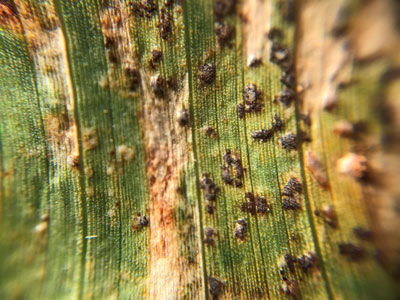
- Phyllachora maydis, one of the causal fungi of tar spot, was reported for the first time in the US in 2015. First in Indiana and then in IL.
- Symptoms begin as oval to irregular bleached to brown lesions on leaves in which black spores are formed. Lesions may also be present on leaf sheaths and husks.
- Not much is known about this disease. It is not known to be seed-borne or infect other plant species.
- P. maydis alone will not cause economic damage or yield losses. Therefore no in-season management is needed for this disease
Biology and Disease Cycle
Tar spot is caused by the fungus Phyllachora maydis. Not known to be seedborne, this pathogenic fungus could be transported on fresh/ dry corn leaves or husks. Ascospores of P. maydis would then be moved by wind or rain splash to corn. The disease is favored by cool temperatures, high relative humidity and long periods of leaf wetness. Windborne spores are released in periods of high humidity. Disease development generally starts at flowering time but infection can occur as early as V8 to V10. P. maydis does not survive well in the absence of a host plant and it is not known whether the fungus can survive a Midwest winter.
To cause economic damage the "tar spot complex" needs to be present. The tar spot complex consists of two pathogenic fungi; P. maydis and Monographella maydis. Fortunately since it was first identified in IN and IL in 2015, P. maydis is the only fungus reported in the U.S.
Symptoms
Tar spot symptoms include small, raised, black spots scattered across the leaf surface (Pic. 1) although spots can also be present on leaf sheaths and husks. These black spots are the fruiting structures (ascomata) of P. maydis. They protrude from the leaf surface giving it a rough or bumpy feel. They can be small flecks of about 1/64" up to about 5/64". The lesions can merge together producing larger areas of blighted leaf tissue.
Symptoms of tar spot can be confused with common and southern rust. Late in the growing season rust fungi switch from producing orange-red pustules to black teliospores. These black pustules can be easily mistaken for tar spot lesions. One way to distinguish them is by scraping away the pustules with your fingertips. Tar spot lesions will not be scraped off the leaf tissue while rust spores will rub off.
Management
In the majority of the cases in which this disease has been reported, symptoms have been detected late in grain fill and at low severity levels. No in-season management is needed as it is unlikely that tar spot alone will cause any economic damage. However in tropical areas of Mexico and Central America where tar spot is common P. maydis in combination with Monographella maydis, can result in yield losses. Fortunately M. maydishas not been detected in the U.S.
P. Maydis has not been reported to be seed borne so no phytosanitary restrictions have been established. Additionally there is no knowledge to date of whether certain corn hybrids differ in their resistance to tar spot. When it was found in Indiana, it had been detected across a range of corn hybrids. More research is needed on this matter. There are currently no fungicides labeled for tar spot in the U.S.
Suggested reading:
- Chalkley, D..Systematic Mycology and Microbiology Laboratory, ARS, USDA. . Invasive Fungi. Tar spot of corn-Phyllachora maydis)
- https://www.extension.purdue.edu/extmedia/BP/BP-90-W.pdf
Picture: Close up of tar spot lesions. Note the raised black lesions scattered on the leaf surface. (Source: GROWMARK, Inc.).